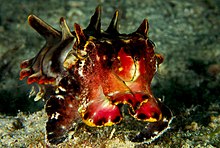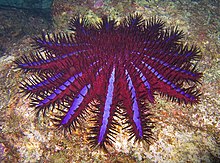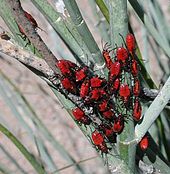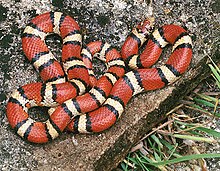Aposematism

Aposematism (from Greek ἀπό apo away, σ̑ημα sema sign, coined by Edward Bagnall Poulton[1][2]), perhaps most commonly known in the context of warning coloration, describes a family of antipredator adaptations where a warning signal is associated with the unprofitability of a prey item to potential predators.[3] Aposematism is one form of an "advertising" signal (with many others existing, such as the bright colours of flowers which lure pollinators). The warning signal may take the form of conspicuous colours, sounds, odours[4] or other perceivable characteristics. Aposematic signals are beneficial for both the predator and prey, both of which avoid potential harm.
Aposematism is exploited in Müllerian mimicry, where species with strong defences evolve to resemble one another. By mimicking similarly coloured species, the warning signal to predators is shared, causing them to learn more quickly at less of a cost to each of the species.
Warning signals do not necessarily require that a species actually possesses chemical or physical defences to deter predators. Mimics such as the nonvenomous California mountain kingsnake (Lampropeltis zonata), which has yellow, red, and black bands similar to those of the highly venomous Eastern Coral Snake (Micrurus fulvius), have essentially piggybacked on the successful aposematism of the model. The evolution of a warning signal by a mimicking species that resembles a species that possesses strong defences is known as Batesian mimicry.
Etymology
The term Aposematism was coined by the English zoologist Edward Bagnall Poulton in his 1890 book The Colours of Animals. He based the term on the Ancient Greek words ἀπό apo away, σ̑ημα sema sign, referring to signs that warn other animals away.[1][2]
Defence mechanism

The function of aposematism is to prevent attack, by warning potential predators that the prey animal has defences such as being unpalatable or poisonous. The easily detected warning is a primary defence mechanism, and the non-visible defences are secondary.[5] Aposematic signals are primarily visual, using bright colours and high-contrast patterns such as stripes. Warning signals are honest indications of noxious prey, because conspicuousness evolves in tandem with noxiousness.[6] Thus, the brighter and more conspicuous the organism, the more toxic it usually is.[6] The most common and effective colours are red, yellow, black and white.[7] These colours provide strong contrast with green foliage, resist changes in shadow and lighting, have strong contrast, are highly chromatic, and provide distance dependent camouflage.[7] Some forms of warning coloration provide this distance dependent camouflage by having an effective pattern and colour combination that do not allow for easy detection by a predator from a distance, but are warning-like from a close proximity, allowing for an advantageous balance between camouflage and aposematism.[8] Warning coloration evolves in response to background, light conditions, and predator vision.[9] Visible signals may be accompanied by odours, sounds or behaviour to provide a multi-modal signal which is more effectively detected by predators.[10]

Unpalatability can be created in a variety of ways. Some insects such as the ladybird or tiger moth contain bitter-tasting chemicals,[11] while the skunk produces a noxious odour, and the poison glands of the poison dart frog, the sting of a velvet ant or neurotoxin in a black widow spider make them dangerous or painful to attack. Tiger moths advertise their unpalatability by either producing ultrasonic noises which warn bats to avoid them,[12] or by warning postures which expose brightly coloured body parts (see Unkenreflex), or exposing eyespots. Velvet ants (actually parasitic wasps) such as Dasymutilla occidentalis both have bright colours and produce audible noises when grabbed (via stridulation), which serve to reinforce the warning.[13]
Prevalence

In terrestrial ecosystems
Aposematism is widespread in insects, but less so in vertebrates, being mostly confined to a smaller number of reptile, amphibian, and fish species. Perhaps the most numerous aposematic vertebrates are the poison dart frogs.[14] Some plants are thought to employ aposematism to warn herbivores of unpalatable chemicals or physical defences such as prickled leaves or thorns.[15] Many insects, such as cinnabar moth caterpillars, acquire toxic chemicals from their host plants.[16] Among mammals, skunks and zorillas advertise their foul-smelling chemical defences with sharply contrasting black-and-white patterns on their fur.[17] Some brightly coloured birds such as passerines with contrasting patterns may also be aposematic, at least in females; but since male birds are often brightly coloured through sexual selection, and their coloration is not correlated with edibility, it is unclear whether aposematism is significant.[18]

In marine ecosystems

The existence of aposematism in marine ecosystems is controversial.[21] Many marine organisms, particularly those on coral reefs, are brightly coloured or patterned, including sponges, corals, molluscs and fishes, with little or no connection to chemical or physical defenses. Caribbean reef sponges are brightly coloured, and many of them are chemically defended, but there is no relationship between the two factors.[22]
Nudibranch molluscs are the most commonly cited examples of aposematism in marine ecosystems, but the evidence for this has been contested,[23] mostly because (1) there are few examples of mimicry among species, (2) many species are nocturnal or cryptic, and (3) bright colours at the red end of the colour spectrum are rapidly attenuated as a function of water depth. For example, the Spanish Dancer nudibranch (genus Hexabranchus), among the largest of tropical marine slugs, potently chemically defended, and brilliantly red and white, is nocturnal and has no known mimics. Mimicry is to be expected as Batesian mimics with weak defences can gain a measure of protection from their resemblance to aposematic species.[24] Other studies have concluded that nudibranchs such as the slugs of the family Phyllidiidae from Indo-Pacific coral reefs are aposematically coloured.[25] Müllerian mimicry has been implicated in the coloration of some Mediterranean nudibranchs, all of which derive defensive chemicals from their sponge diet.[26]
The crown-of-thorns starfish, like other starfish such as Metrodira subulata, has conspicuous coloration and conspicuous long, sharp spines, as well as chemical defences in the form of saponins; this evidence is argued to be sufficient for such species to be considered aposematic.[19][20] It has been proposed that aposematism and mimicry is less evident in marine invertebrates than terrestrial insects because predation is a more intense selective force for many insects, which also disperse as adults rather than as larvae and have much shorter generation times. [21] Further, there is evidence that fish predators such as blueheads may adapt to visual cues more rapidly than do birds, making aposematism less effective.[27]
Behaviour
The defence mechanism relies on the memory of the would-be predator; a bird that has once experienced a foul-tasting grasshopper will endeavour to avoid a repetition of the experience. As a consequence, aposematic species are often gregarious. Before the memory of a bad experience attenuates, the predator may have the experience reinforced through repetition. Aposematic organisms often move in a languid fashion, as they have little need for speed and agility. Instead, their morphology is frequently tough and resistant to injury, thereby allowing them to escape once the predator is warned off. Aposematic species do not need to hide or stay still as cryptic organisms do, so aposematic individuals benefit from more freedom in exposed areas and can spend more time foraging, allowing them to find more and better quality food.[28] Aposematic individuals can similarly make use of conspicuous mating displays.[29]
Origins of the theory

Wallace, 1867
Alfred Russel Wallace suggested in a letter to Charles Darwin that the conspicuous colour schemes of some insects might have evolved through natural selection as a warning to predators. Darwin had proposed that conspicuous coloration could be explained in many species by means of sexual selection, but had realised that this could not explain the bright coloration of some caterpillars, since these larvae were not sexually active. Wallace replied that just as the contrasting coloured bands of a hornet warned of its defensive sting, so the bright colours of the caterpillar could warn of its unpalatability. Since Darwin was enthusiastic about the idea, in 1867 Wallace asked the Entomological Society of London to test the hypothesis. In response, the entomologist John Jenner Weir conducted experiments with caterpillars and birds in his aviary, and in 1869 he provided the first experimental evidence for warning coloration in animals.[30]
Poulton, 1890
The concept of warning coloration was extended by Edward Bagnall Poulton in The Colours of Animals (1890):[2]
When an animal possesses an unpleasant attribute, it is often to its advantage to advertise the fact as publicly as possible. In this way it escapes a great deal of experimental 'tasting.' The conspicuous patterns and strongly contrasted colours which serve as the signal of danger or inedibility are known as Warning Colours ... It is these Warning Colours which are nearly always the objects of Protective Mimicry, and it will therefore be convenient to describe the former before the latter.[31]
Poulton introduced the term aposematism in the same book with the words:
The second head (Sematic Colours) includes Warning Colours and Recognition Markings: the former warn an enemy off, and are therefore called Aposematic [Greek, apo, from, and sema, sign][32]
Evolution
Aposematism is paradoxical in evolutionary terms, as it makes individuals conspicuous to predators, so they may be killed and the trait eliminated before predators learn to avoid it. If warning coloration puts the first few individuals at such a strong disadvantage, it would never last in the species long enough to become beneficial.[33]
Supported explanations
There is evidence for explanations involving dietary conservatism, in which predators avoid new prey because it is an unknown quantity;[34] this is a long-lasting effect.[34][35][36] Dietary conservatism has been demonstrated experimentally in some species of birds.[34][36] Further, birds recall and avoid objects that are both conspicuous and foul-tasting longer than objects that are equally foul-tasting but cryptically coloured. This suggests that Wallace's original view, that warning coloration helped to teach predators to avoid prey thus coloured, was correct.[37] However, some birds (inexperienced starlings and domestic chicks) also innately avoid conspicuously coloured objects, as demonstrated using mealworms painted yellow and black to resemble wasps, with dull green controls. This implies that warning coloration works at least in part by stimulating the evolution of predators to receive the warning signal, rather than by requiring each new generation to learn the signal's meaning.[37] All of these results contradict the idea that novel, brightly coloured individuals would be more likely to be eaten or attacked by predators.[34]
Alternative hypotheses
Other explanations are possible. Predators might innately fear unfamiliar forms (neophobia)[38] long enough for them to become established, but this is likely to be only temporary.[33][38][39]
Alternatively, prey animals might be sufficiently gregarious to form clusters tight enough to enhance the warning signal. If the species was already unpalatable, predators might learn to avoid the cluster, protecting gregarious individuals with the new aposematic trait.[40][41] Gregariousness would assist predators to learn to avoid unpalatable, gregarious prey.[42] Aposematism could also be favoured in dense populations even if these are not gregarious.[38][34]
Another possibility is that a gene for aposematism might be recessive and located on the X chromosome.[43] If so, predators would learn to associate the colour with unpalatability from males with the trait, while heterozygous females carry the trait until it becomes common and predators understand the signal.[43] Well-fed predators might also ignore aposematic morphs, preferring other prey species.[33][44]
A further explanation is that females might prefer brighter males, so sexual selection could result in aposematic males having higher reproductive success than non-aposematic males if they can survive long enough to mate. Sexual selection is strong enough to allow seemingly maladaptive traits to persist despite other factors working against the trait.[14]
Once aposematic individuals reach a certain threshold population, for whatever reason, the predator learning process would be spread out over a larger number of individuals and therefore is less likely to wipe out the trait for warning coloration completely.[45] If the population of aposematic individuals all originated from the same few individuals, the predator learning process would result in a stronger warning signal for surviving kin, resulting in higher inclusive fitness for the dead or injured individuals through kin selection.[46]
Mimicry


Aposematism is a sufficiently successful strategy to have had significant effects on the evolution of both aposematic and non-aposematic species.
Non-aposematic species have often evolved to mimic the conspicuous markings of their aposematic counterparts. For example, the Hornet Moth is a mimic of the yellowjacket wasp; it resembles the wasp, but has no sting. A predator which avoids the wasp will to some degree also avoid the moth. This is known as Batesian mimicry, after Henry Walter Bates, a British naturalist who studied Amazonian butterflies in the second half of the 19th century.[47] Batesian mimicry is frequency dependent: it is most effective when the ratio of mimic to model is low; otherwise, predators learn to recognise the impostors.[48][49]
A second form of mimicry occurs when two aposematic organisms share the same anti-predator adaptation and mimic each other, to the benefit of both species, since fewer individuals of either species need to be attacked for predators to learn to avoid both of them. This form of mimicry is known as Müllerian mimicry, after Fritz Müller, a German naturalist who studied the phenomenon in the Amazon in the late 19th century.[50][51] Many species of bee and wasp that occur together are Müllerian mimics; their similar coloration teaches predators that a striped pattern is associated with being stung. Therefore, a predator which has had a negative experience with any such species will likely avoid any that resemble it in the future. Müllerian mimicry is found in vertebrates such as the mimic poison frog (Ranitomeya imitator) which has several morphs throughout its natural geographical range, each of which looks very similar to a different species of poison frog which lives in that area.[52]
See also
References
- ^ a b Poulton, 1890. Foldout "The Colours of Animals Classified According to Their Uses", after page 339.
- ^ a b c Marek, Paul. "Aposematism". Apheloria. Retrieved November 24, 2012.
- ^ Santos, J.C.; Coloma, Luis A.; Cannatella, D.C. (2003). "Multiple, recurring origins of aposematism and diet specialization in poison frogs". PNAS October 28, 2003. doi:10.1073/pnas.100.22.12792.
{{cite journal}}: Cite journal requires|journal=(help)CS1 maint: multiple names: authors list (link) - ^ Eisner, T; Grant, RP (1981). "Toxicity, Odor Aversion, and 'Olfactory Aposematism'". Science. 213 (4506): 476. doi:10.1126/science.7244647. PMID 7244647.
- ^ Ruxton, G. D.; Sherratt, T. N.; Speed, M. P. (2004). Avoiding Attack: The Evolutionary Ecology of Crypsis, Warning Signals and Mimicry. Oxford University Press. ISBN 0-19-852859-0.
- ^ a b Maan, M. E.; Cummings, M. E. (2012). "Poison frog colors are honest signals of toxicity, particularly for bird predators". American Naturalist. 179 (1): E1–E14. JSTOR 663197.
- ^ a b Stevens, M.; Ruxton, G. D. (2012). "Linking the evolution and form of warning coloration in nature". Proceedings of the Royal Society B-Biological Sciences. 279: 417–426. doi:10.1098/rspb.2011.1932.
- ^ Tullberg, B. S., Merilaita S., & Wiklund, C. (2005). "Aposematism and Crypsis Combined as a Result of Distance Dependence: Functional Versatility of the Colour Pattern in the Swallowtail Butterfly Larva". Proceedings: Biological Sciences. 272 (1570): 1315–1321. doi:10.1098/rspb.2005.3079.
{{cite journal}}: CS1 maint: multiple names: authors list (link) - ^ Wang, I. J.; Shaffer, H. B. (2008). "Rapid color evolution in an aposematic species: A phylogenetic analysis of color variation in the strikingly polymorphic strawberry poison-dart frog". Evolution. 62 (11): 2742–2759. doi:10.1111/j.1558-5646.2008.00507.x. PMID 18764916.
- ^ MacAuslane, Heather J. Macauslane (2008). "Aposematism". In Capinera (ed.). Encyc. Entom. Vol. 4. pp. 239–242.
- ^ Hristov, N. I.; Conner, W. E. (2005). "Sound strategy: acoustic aposematism in the bat–tiger moth arms race". Naturwissenschaften. 92 (4): 164–169. doi:10.1007/s00114-005-0611-7. PMID 15772807.
- ^ Hristov, & William E. Conner. (2005).
- ^ Schmidt, J. O. And Blum, M. S. (1977), Adaptations and Responses of Dasymutilla occidentalis (Hymenoptera: Mutillidae) to Predators. Entomologia Experimentalis et Applicata, 21: 99–111. doi: 10.1111/j.1570-7458.1977.tb02663.x
- ^ a b Maan, M. E.; Cummings, M. E. (2009). "Sexual dimorphism and directional sexual selection on aposematic signals in a poison frog". Proceedings of the National Academy of Sciences of the United States of America. 106: 19072–19077. doi:10.1073/pnas.0903327106. PMC 2776464. PMID 19858491.
- ^ Rubino, Darrin L.; McCarthy, Brian C. "Presence of Aposematic (Warning) Coloration in Vascular Plants of Southeastern Ohio" Journal of the Torrey Botanical Society, Vol. 131, No. 3 (Jul-Sep 2004), pp. 252-256. http://www.jstor.org/stable/4126955
- ^ Edmunds, 1974. pp. 199–201.
- ^ Caro, T. (2009). Contrasting coloration in terrestrial mammals. Philosophical Transactions of the Royal Society B: Biological Sciences, 364(1516), 537–548. doi:10.1098/rstb.2008.0221
- ^ Götmark, Frank. "Are Bright Birds Distasteful? A Re-Analysis of H. B. Cott's Data on the Edibility of Birds". Journal of Avian Biology, Vol. 25, No. 3 (Aug 1994), pp. 184-197. http://www.jstor.org/stable/3677074
- ^ a b Shedd, John G. (2006). "Crown of Thorns Sea Star". Shedd Aquarium. Retrieved 21 June 2015.
- ^ a b Inbar, Moshe; Lev-Yadun, Simcha (2005). "Conspicuous and aposematic spines in the animal kingdom" (PDF). Naturwissenschaften. 92: 170–172. doi:10.1007/s00114-005-0608-2.
defensive animal spines are often conspicuous (shape and colour) and should be considered aposematic... Classic examples are the starfishes Acanthaster planci and Metrodira subulata, which have red spines...
- ^ a b Pawlik, J.R. (2012). Fattorusso, E.; et al. (eds.). Antipredatory defensive roles of natural products from marine invertebrates. NY: Springer. pp. 677–710.
{{cite book}}:|work=ignored (help); Explicit use of et al. in:|editor-first=(help) - ^ Pawlik, JR; et al. (1995). "Defenses of Caribbean sponges against predatory reef fish: I. Chemical deterrency". Marine Ecology Progress Series. 127: 183–194.
{{cite journal}}: Explicit use of et al. in:|first=(help) - ^ Edmunds, M (1991). "Does warning coloration occur in nudibranchs?". Malacologia. 32: 241–255.
- ^ Pawlik, JR; et al. (1988). "Defensive chemicals of the Spanish Dancer nudibranch, Hexabranchus sanguineus, and its egg ribbons: Macrolides derived from a sponge diet". Journal of Experimental Marine Biology and Ecology. 119: 99–109.
{{cite journal}}: Explicit use of et al. in:|first=(help) - ^ Ritson-Williams, R; Paul, VJ (2007). "Marine benthic invertebrates use multimodal cues for defense against reef fish". Marine Ecology Progress Series. 340: 29–39. doi:10.3354/meps340029.
- ^ Haber, M.; et al. (2010). "Coloration and defense in the nudibranch gastropod Hypselodoris fontandraui". Biological Bulletin. 218: 181–188.
{{cite journal}}: Explicit use of et al. in:|first=(help) - ^ Miller, AM; Pawlik, JR (2013). "Do coral reef fish learn to avoid unpalatable prey using visual cues?". Animal Behaviour. 85: 339–347. doi:10.1016/j.anbehav.2012.11.002.
- ^ Speed, M. P.; Brockhurst, M. A.; Ruxton, G. D. (2010). "The dual benefits of aposematism: predator avoidance and enhanced resources collection". Evolution. 64 (6): 1622–1633. doi:10.1111/j.1558-5646.2009.00931.x. PMID 20050915.
- ^ Rudh, A.; Rogell, B.; Håstad, O.; Qvarnström, A. (2011). "Rapid population divergence linked with co-variation between coloration and sexual display in strawberry poison frogs". Evolution. 65: 1271–1282. doi:10.1111/j.1558-5646.2010.01210.x.
- ^ Slotten, Ross (2004). "The Heretic in Darwin's Court:The Life of Alfred Russel Wallace". New York: Columbia University Press: 253–524. ISBN 0-231-13010-4.
{{cite journal}}: Cite journal requires|journal=(help) - ^ Poulton, 1890. p21.
- ^ Poulton, 1890. pp 337–338.
- ^ a b c Mappes, Johanna; Marples, Nicola; Endler, John A. (2005). "The complex business of survival by aposematism". Trends in Ecology and Evolution. 20 (11): 598–603. doi:10.1016/j.tree.2005.07.011.
- ^ a b c d e Thomas, R. J.; Marples, N. M.; Cuthill, I. C.; Takahashi, M.; Gibson, E. A. (2003). "Dietary conservatism may facilitate the initial evolution of aposematism". Oikos. 101 (3): 548–566. doi:10.1034/j.1600-0706.2003.12061.x.
- ^ Marples, Nicola M.; Kelly, David J.; Thomas, Robert J. (2005). "Perspective: The evolution of warning coloration is not paradoxical". Evolution. 59 (5): 933–940. doi:10.1111/j.0014-3820.2005.tb01032.x. PMID 16136793.
- ^ a b Lindstrom, Leena; Altalo, Rauno V.; Lyytinen, Anne; Mappes, Johanna (2001). "Predator experience on cryptic prey affects the survival of conspicuous aposematic prey". Proceedings of the Royal Society. 268 (1465): 357–361. doi:10.1098/rspb.2000.1377.
- ^ a b Roper, Tim J. (9 July 1987). New Scientist. Reed Business Information. pp. 50–52. ISSN 02624079 Parameter error in {{issn}}: Invalid ISSN..
- ^ a b c Speed, Michael P. (2001). "Can receiver psychology explain the evolution of aposematism?". Animal Behaviour. 61: 205–216. doi:10.1006/anbe.2000.1558.
- ^ Exernova, Alice; Stys, Pavel; Fucikova, Eva; Vesela, Silvie; Svadova, Katerina; Prokopova, Milena; Jarosik, Vojtech; Fuchs, Roman; Landova, Eva (2007). "Avoidance of aposematic prey in European tits (Paridae): learned or innate?". Behavioral Ecology. 18 (1): 148–156. doi:10.1093/beheco/arl061.
- ^ Gamberale, Gabriella; Tullberg, Birgitta S. (1998). "Aposematism and gregariousness: the combined effect of group size and coloration on signal repellence". Proceedings of the Royal Society: Biological Sciences. 265 (1399): 889–894. doi:10.1098/rspb.1998.0374.
- ^ Mappes, Johanna; Alatalo, Rauno V. (1996). "Effects of novelty and gregariousness in survival of aposematic prey". Behavioral Ecology. 8 (2): 174–177. doi:10.1093/beheco/8.2.174.
- ^ Ruxton, Graeme D.; Sherratt, Thomas N. (2006). "Aggregation, defense, and warning signals: the evolutionary relationship". Proceedings of the Royal Society. 273: 2417–2424. doi:10.1098/rspb.2006.3570.
- ^ a b Brodie, Edmund D. III; Agrawal, Anell F. (2001). "Maternal effects and the evolution of aposematic signals". Proceedings of the National Academy of Sciences. 58 (14): 7884–7887. doi:10.1073/pnas.141075998.
- ^ Merilaita, Sami; Kaitala, Veijo (2002). "Community structure and the evolution of aposematic coloration". Ecology Letters. 5 (4): 495–501. doi:10.1046/j.1461-0248.2002.00362.x.
- ^ Lee, T. J.; Marples, N. M.; Speed, M. P. (2010). "Can dietary conservatism explain the primary evolution of aposematism?". Animal Behaviour. 79: 63–74. doi:10.1016/j.anbehav.2009.10.004.
- ^ Servedio, M. R. (2000). "The effects of predator learning, forgetting, and recognition errors on the evolution of warning coloration". Evolution. 54: 751–763. doi:10.1111/j.0014-3820.2000.tb00077.x.
- ^ Bates, H. W. (1861). "Contributions to an insect fauna of the Amazon valley. Lepidoptera: Heliconidae". Transactions of the Linnean Society. 23 (3): 495–566. doi:10.1111/j.1096-3642.1860.tb00146.x.; Reprint: Bates, Henry Walter (1981). "Contributions to an insect fauna of the Amazon valley (Lepidoptera: Heliconidae)". Biological Journal of the Linnean Society. 16 (1): 41–54. doi:10.1111/j.1095-8312.1981.tb01842.x.
- ^ Harper, G. R; Pfennig, D. W (22 August 2007). "Mimicry on the edge: why do mimics vary in resemblance to their model in different parts of their geographical range?". Proceedings of the Royal Society B: Biological Sciences. 274 (1621): 1955–1961. doi:10.1098/rspb.2007.0558. PMC 2275182. PMID 17567563.
- ^ Edmunds, 1974. Page 112.
- ^ Müller, Fritz (1878). "Ueber die Vortheile der Mimicry bei Schmetterlingen". Zoologischer Anzeiger. 1: 54–55.
- ^ Müller, F. (1879). "Ituna and Thyridia; a remarkable case of mimicry in butterflies. (R. Meldola translation)". Proclamations of the Entomological Society of London. 1879: 20–29.
- ^ Twomey, Evan; Brown, Jason (1986). "Ranitomeya imitator". Dendrobates.org. Retrieved 11 May 2015.
Sources
- Capinera, John L., ed. (2008). Encyclopedia of Entomology (2nd ed.). Springer. ISBN 978-1-4020-6242-1.
- Edmunds, M. (1974). Defence in Animals. Longman. ISBN 0-582-44132-3.
- Poulton, Edward Bagnall (1890). The Colours of Animals, their meaning and use, especially considered in the case of insects. London: Kegan Paul, Trench & Trübner.
{{cite book}}: External link in|title= - Ruxton, G. D.; Speed, M. P.; Sherratt, T. N. (2004). Avoiding Attack. The Evolutionary Ecology of Crypsis, Warning Signals and Mimicry. Oxford University Press. ISBN 0-19-852860-4

